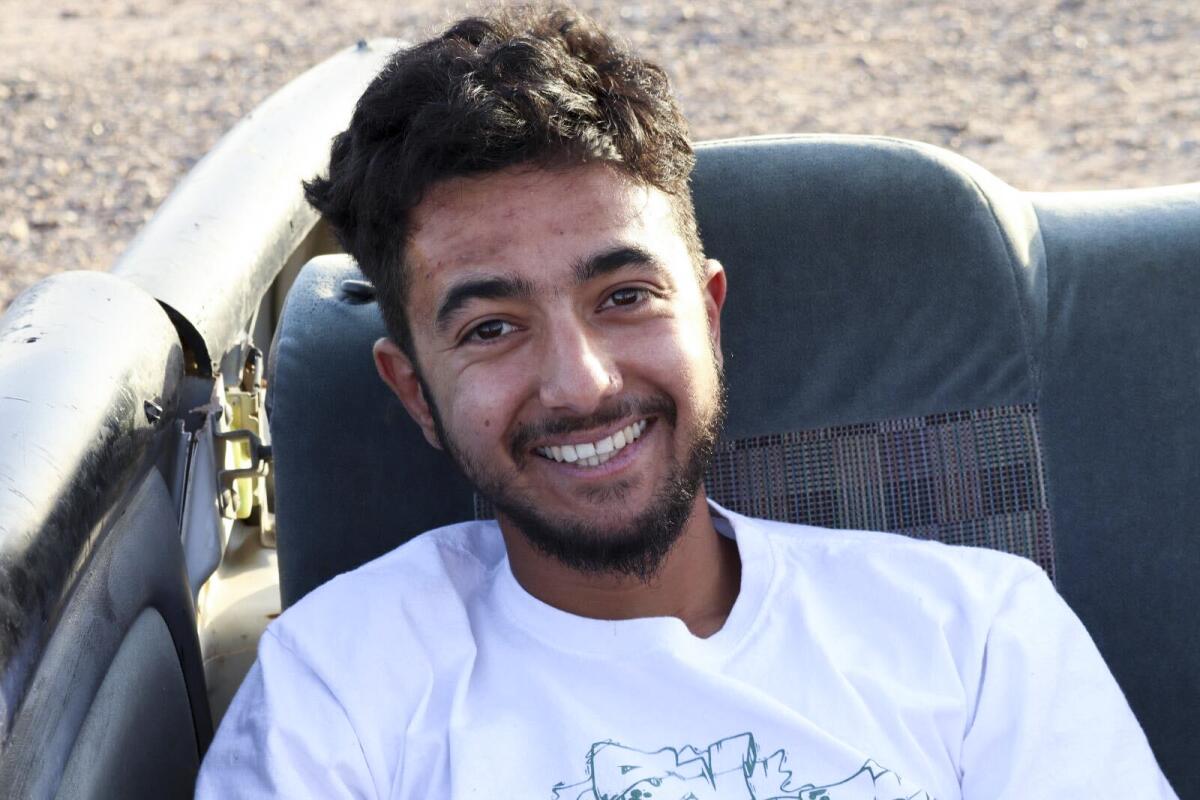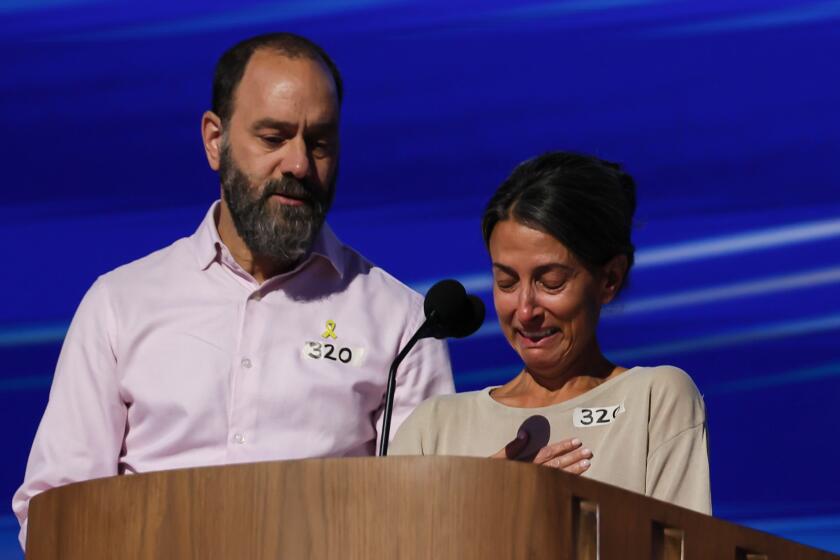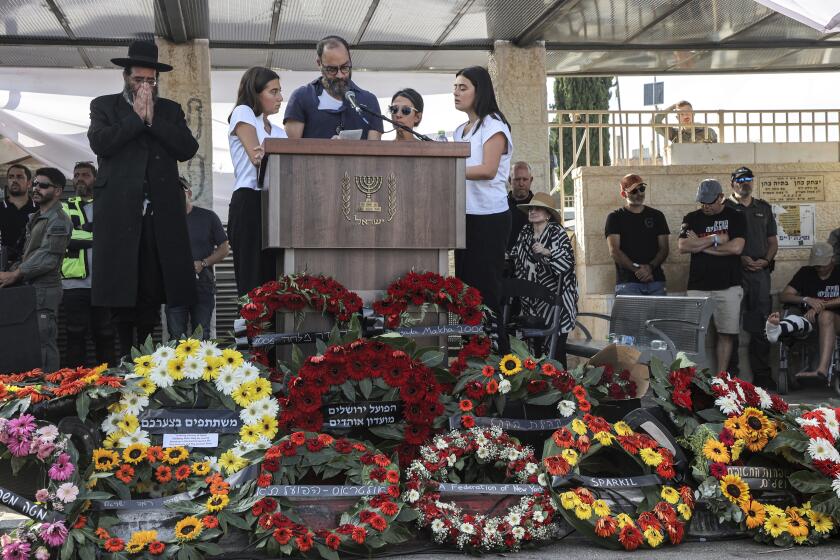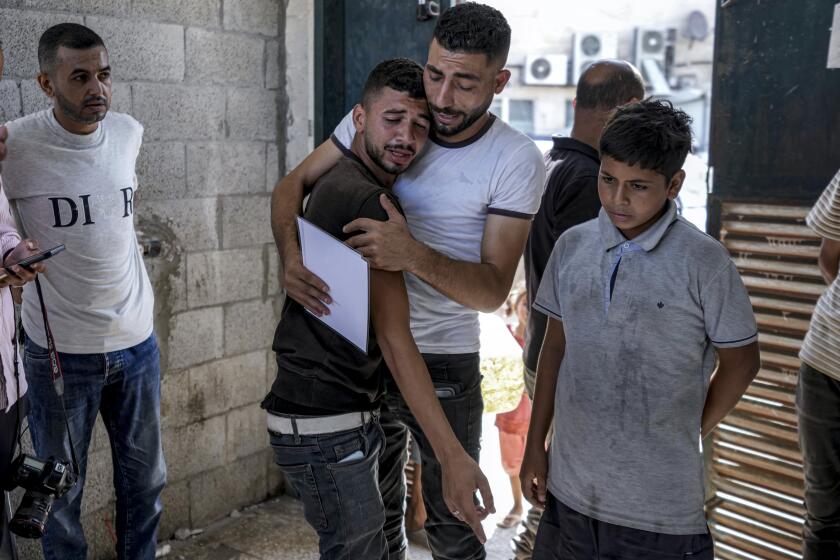Hamas releases video of slain hostage Hersh Goldberg-Polin: ‘I miss you’

- Share via
TEL AVIV — He appeared pale, but sounded calm. And he somehow looked both younger and older than his 23 years.
“Mama, Dada, Leebie and Orly, I love you, I miss you,” Hersh Goldberg-Polin said, looking directly into the camera and addressing his parents and two sisters. “And I’m thinking about you every single day.”
The Palestinian militant group Hamas late Thursday released 1-minute, 42-second video of the Berkeley-born U.S. and Israeli citizen, who was killed last week along with five other Israeli hostages in a tunnel beneath the Gaza Strip. They had been held for nearly 11 months, abducted by Hamas-led attackers in the war’s first hours. In the undated video, Goldberg-Polin said he hoped to see his family again.
Israeli officials say the six hostages were shot execution-style by their captors last Thursday or Friday while Israeli troops carried out operations nearby, in the southern Gaza city of Rafah. Word that the bodies had been discovered, and the subsequent confirmation of the identities of the six, plunged the country into mourning.
The killings set off huge street demonstrations, with protesters demanding that Prime Minister Benjamin Netanyahu strike a cease-fire deal to release dozens of Israeli captives thought to still be alive in Gaza.
Hamas has made frequent use of such videos over the course of the war. The Israeli government denounces them as crude propaganda, aimed at demoralizing and dividing the country. Israeli news outlets generally do not air them, except for portions specifically approved by the families for general viewing.
Grief and anger in Israel as authorities say Hersh Goldberg-Polin, a native of Berkeley, and five other hostages were killed in Gaza. Many direct fury at Israeli Prime Minister Benjamin Netanyahu.
Presumed to be made under duress, the Hamas-produced videos have invariably featured the captives pleading with Israeli leaders to make a deal to free them, sometimes offering harshly critical commentary about the Israeli government’s failure to do so. This video did as well, with criticism also leveled at the Biden administration.
It was unknown when Hamas made the individual recordings of the six. But there was at least one hint that the videos might be several months old: One of the late hostages, Carmel Gat, described herself as being 39 years old. She had turned 40 in May.
Hamas released initial video snippets of the hostages on Sunday, only hours after Israeli officials confirmed the killings and the names of the dead. Those clips, which showed each of the six reciting their names and hometowns, were posted in a channel on the Telegram messaging app affiliated with Hamas’ armed wing, as were the longer versions released over the course of this week.
In the first of them, a 24-year-old hostage named Eden Yerushalmi, who appeared emaciated, with dark circles under her eyes, told her family she loved and missed them. But she also wagged an admonishing finger as she complained of continuing captivity and the Israeli government’s failure to act to free her and the others.
Her family, in a statement, called it a “shocking psychological terror video.”
In Israel, thousands honored Hersh Goldberg-Polin, a California native and the only U.S. citizen among six hostages found killed in Gaza.
Goldberg-Polin’s American-born parents had staged a high-profile international campaign to try to win his release, and to much of the outside world, he was a familiar face, a well-known symbol of the hostages’ fate. Perhaps because of that prominence, Hamas saved the release of his video for last.
In it, the young man, lightly bearded and wearing a dark-red shirt, described harsh conditions in captivity.
“Since I arrived in Gaza, I survived with almost no medical care, little food, little water,” he said. “I can’t remember the last time I saw the sun or took a breath of fresh air.”
But he expressed hopes for his freedom, saying, “I believe I’ll be home soon.”
Back in April, another video of Goldberg-Polin had offered his family the first proof that he was alive. Until then, they were not sure he had survived the day of his abduction, when his left arm was blown off below the elbow by a grenade that assailants threw into a bomb shelter where he had taken refuge with others who had been attending an open-air music festival.
In that video, with his bandaged arm visible, he called on his parents to stay strong.
Most of the six, including Goldberg-Polin, were seized from the all-night desert rave that was underway when Hamas attackers burst through the border fence and struck southern Israel, killing about 1,200 people and seizing approximately 250 hostages. Gat, from Tel Aviv, was visiting her mother in a small farming community that was one of those attacked.
Israel’s retaliatory attacks in Gaza have killed more than 41,000 Palestinians, according to the territory’s Health Ministry, whose numbers do not differentiate between civilians and combatants. Nearly all of the population of Gaza has been displaced, hunger and disease are rampant, and entire neighborhoods have been bombed into rubble.
Mohammad Abu Al-Qumsan lost his children, wife, and mother-in-law in an Israeli strike that hit a Gaza Strip apartment building while he was away.
Thousands of mourners turned out Tuesday for Goldberg-Polin’s funeral in Jerusalem, where he was eulogized by speaker after speaker, including the country’s president, Isaac Herzog, who asked for forgiveness on behalf of the Israeli state.
His mother, Rachel Goldberg, delivered a piercing lament.
“My sweet boy,” she said. “Finally, finally, finally, you’re free.”
Times staff writer Nabih Bulos in Washington contributed to this report.
More to Read
Sign up for Essential California
The most important California stories and recommendations in your inbox every morning.
You may occasionally receive promotional content from the Los Angeles Times.












